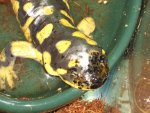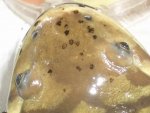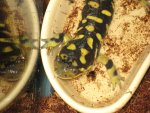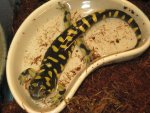I have not experienced anything like this with my tigers. My only experience with a 'black spot' was a small black cyst (the size of the head of a straight pin) on a tiger's tail. It was slightly raised. It was removed by a vet, and diagnosed as benign.
Here are some thoughts, although I am not a vet. This might be a bacterial dermatitis - bacterial skin infections in amphibians can manifest as brown to black spots on the animal. In that you indicate that the spots are progressing, this could be suggestive of an infection. If this is the case, if left untreated, it could spread to a generalized infection. I would recommend having the animal seen by a vet that has experience in treating amphibians. If you need help with this, pm me with your location and I can send you listings of potential vets in your area.
Is, or has the animal been exposed to UV light or direct sunlight? I'm reaching here, but over production of melanin could potentially result from severe exposure. Of course, either would be inappropriate for the animal.
If you have other tigers in the same enclosure, I would quarrantine this one. I would also maintain the sal in a hospital environment so that it can be monitored. White paper towels moistened with dechlorinated or spring water with some crumpled moistened paper towels as hides will work. Keep it in a cool, dark environment. I would also disinfect its current enclosure to be on the safe side and not re-introduce it to this environment until the problem has been resolved or at least until diagnosed...then follow vet recommendations.
Please let us know outcomes.
 I have looked up infections and I could not find anything. The bumps are a little raised and I think he might be developing more . A picture of the spots is attached
I have looked up infections and I could not find anything. The bumps are a little raised and I think he might be developing more . A picture of the spots is attached





